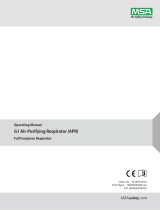Page is loading ...

º
70-0714-1896-8
© 3M 2007. All rights reserved.
How do I monitor for Cr(VI)?
Consult an American Industrial Hygiene Association (AIHA)
accredited laboratory for assistance on selection of the appropriate
sampling and analytical method. To contact an AIHA accredited
laboratory or an Industrial Hygienist to do the monitoring for you,
go to www.aiha.org and select Consultants or Laboratories or go
to your 3M OH&ES Sales Representative.
When are respirators required?
Respirators are required in the following situations when exposure
levels exceed the PEL:
• While engineering and work practice controls are
being developed
• During maintenance and repair activities for which engineering
and work practice controls are not feasible
• When all feasible engineering and work practice controls are
implemented and are still not sufficient to reduce exposures to or
below the PEL
• When employees are exposed above the PEL for fewer than 30
days per year and the employer has not elected to implement
engineering and work practice controls
• Emergencies
Which respirator should I use?
Respirators should be chosen by the employer based on workplace
conditions and contaminant levels. In other words:
• N95 filters may be used where no oil aerosols are present,
R or P95 filters where oil aerosols are present
• Filtering facepiece respirators, elastomeric half facepiece
respirators and full facepiece respirators, when qualitatively fit
tested, may be used up to 10 x PEL with appropriate filters
• Full facepiece respirators may be used up to 50 x PEL when
they are quantitatively fit tested and are equipped with
appropriate filters
• Loose fitting facepieces may be used up to 25 x PEL
• Tight fitting full facepieces, hoods and helmets with supplied air
or powered air purifying respirator may be used up to
1000 x PEL
I have not had a respiratory protection program. What
information do I need to get started?
The standard requires the respiratory protection program, including
respirator selection, to follow OSHA 1910.134 requirements.
What if I have additional questions?
Contact your local 3M Sales Representative, the 3M Occupational
Health and Environmental Safety Division (OH&ESD) Technical
Hotline at 1-800-243-4630 or www.HexChrom.com. For complete
details on the Cr(VI) standard go to www.OSHA.gov.
On February 28, 2006 the Occupational Safety and Health
Administration (OSHA) published the final Hexavalent
Chromium Cr(VI) Standard. The new permissible exposure
limit (PEL) for Cr(VI) is 5μg/m
3
(micrograms per cubic
meter) as an eight-hourtime-weighted average (TWA).
On April 6, 2007 OSHA settled a legal challenge with
labor unions and agreed to follow specific inspection
procedures on construction sites where Portland Cement
is used.
Portland Cement contains small amounts of Hexavalent
Chromium, and is exempt from the Cr(VI) standard. This
settlement does not affect the exempt status of Portland
Cement, however, under the settlement, OSHA provided
inspectors with specific inspection procedures required for
construction sites using Portland Cement. OSHA
inspectors will use other OSHA standards, not the Cr(VI)
standard to determine compliance. It was determined that
compliance with pre-existing OSHA general standards
provides adequate protection for employees.
What is hexavalent chromium?
Hexavalent Chromium Cr(VI) is a metal particle. It has the
ability to gain electrons from other elements (a strong
oxidizer) which means it can react easily with other elements.
Because of its ability to react with other elements it can
produce hard coatings, which is why it is used in paints for
cars, boats and airplanes.
What type of filter is effective?
It can be filtered with an N95 filter or an R or P95 filter if oil
mist is present.
What are the main applications affected?
The main applications are welding (especially on stainless
steel), spraying heavy duty coatings, paints and
chrome plating.
How does this impact me?
Employers must reassess their respirator program taking into
consideration the lower exposure limit.
Cr(VI)
Questions and Answers
Frequently Asked Questions and
Answers Regarding the Hexavalent
Chromium Cr(VI) Standard
/


